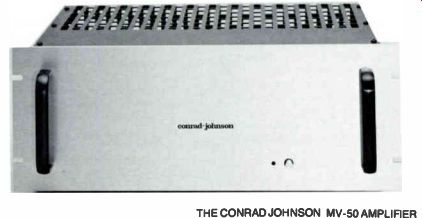| Home | Audio mag. | Stereo Review mag. | High Fidelity mag. | AE/AA mag.
|
by Anthony H. C.
THE CONRAD JOHNSON MV-50 AMPLIFIER

Stereo tube amplifier. Rated power: 50 W/ch. Frequency response: 20-15,000 Hz.
IM or THD: less than 1%. Price: $1385.
MANUFACTURER: Conrad Johnson Design, 2800R Dorr Ave., Fairfax, VA 22031. (703) 698-8581.
If you've ever wondered why reviewers keep harping on the differences between tube and transistor gear, you might want to listen to the Conrad Johnson MV-50. The MV-50, a classic example of a tube amplifier, is far more limited in power than most transistor amplifiers in its price range; it lacks the damping and bass control of its transistor counterparts, and sounds rolled off in the upper octaves. These limitations, all typical of reasonably priced tube amplifiers, are clearly apparent.
At the same time, the MV-50 offers a number of advantages that may make it perfect for your system if you are limited in space, or use small- to medium-sized monitor speakers. It has an extraordinarily sweet and detailed ability to reproduce music in the range from 80 Hz to 7 kHz.
This is the critical area for high resolution and transparency in music, and outstanding performance in this region is usually far more important subjectively than superior performance in the deep bass or top octaves.
The MV-50's lack of power and control in the deep bass will not affect its performance with most of the speakers it is likely to be used with (they have no deep bass to begin with, and most such speakers do not benefit strikingly from high damping factors), and the subjective nature of the MV-50's highs does not mean that it fails to communicate musical overtones and upper harmonics. They're simply less present- which means that the MV-50 corrects for the inherent imbalance in small monitors like the Spica TC-50, most British speakers, and any other speaker with flat highs but limited bass power.' Further, the MV-50 makes up for a multitude of sins in the front end. It is a perfect counterbalance to the rising high end in most medium-price moving coils, and it soothes the savage breast of most affordable CD players.
More importantly, the MV-50 provides the kind of midrange that simply is not available in most amplifiers at any price.
When you borrow an MV-50 from a dealer or friend, begin by listening to the imaging and depth. If you listen on good speakers with high resolving power, you will immediately hear the image "float" in a wide soundstage where each instrument has its natural place, without being "etched" or overly detailed in terms of location. You also will hear a natural balance of depth and soundstage height and width. Granted, other gear does all of this better-the top-priced Conrad Johnson, Audio Research, Counterpoint. Krell, and New York Audio Labs amplifiers, for example-but none ex cept the Quicksilver mono amplifiers does it anywhere near as well at this price.
Now listen to voice, strings, or wood winds. Don't pick an audio spectacular, just a few of your favorite records. You will at first be struck by the lack of upper octave energy, and-if your current amplifier is ...
[1. The ear seems to prefer balance in upper and lower runoffs. A system whose highs are extended. for instance.]
... sounds unnatural without extended bass. -LA typically transistor-the lack of etched or hard treble detail. Listen a few moments longer, however, and you will begin to hear the kind of harmonic sweetness and musical information that's present in live music, but rarely heard in a home system. The MV-50 won't win on specmanship, but will win on its ability to make most records and CDs sound naturally musical, giving you far more sustained pleasure in the actual hearing of music.
These differences are the raison del re behind this product; you will like them enough to buy the Conrad-Johnson MV 50, or you shouldn't buy it at all. A good transistor amp like the Adcom 555 will give you everything else at a much lower price.
I suggest, however, that you give the MV 50 an audition if you have previously ignored tube amplifiers on the grounds of price and size, or simply wondered why those reviewers who concentrate on subjective testing keep harping on tubes.
I also recommend that you listen to this amplifier if you seek to build a medium priced system designed for sustained listening pleasure. The MV-50 is not a product likely to strike you as quickly as its transistor competitors, but give it an hour or so of listening-you may well find its "natural" sound far more important. If you find yourself irritated or fatigued by the highs in your system, or by the overall hardness and grain that comes from playing most modern records and CDs through a typical low- to medium-priced system, you may well find the MV -50 a suitable antidote.
--
[based on a March 1986, Stereophile review article]
Also see:
THE NEC CD-705E COMPACT DISC PLAYER
THE INFINITY IRS-III AND RS-IB: STILL FURTHER CONSIDERATIONS
THE RAUNA TYR MARK II LOUDSPEAKER
THE SYNTHESIS LM-20 AND LM-250: A NEW LINE OF TOP QUALITY SPEAKERS
Prev. | Next |